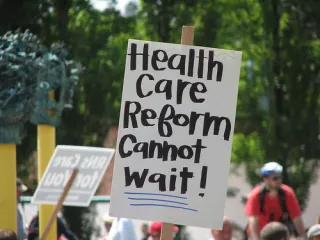- | Healthcare Healthcare
- | Research Papers Research Papers
- |
The Unindicted Conspirator
High Healthcare Spending and the Rise of Third-Party Payment
The healthcare sector has come to be dominated by third-party payers. Insurance companies and government bureaucracies pay the bills for the medical care that Americans consume, and they have become an unquestioned fixture of the healthcare landscape. Meanwhile, the growth in third-party payment has coincided with a massive increase in healthcare costs and a decline in quality.
National Center for Policy Analysis Senior Fellow John R. Graham evaluates the roots of third-party payment in the United States and analyzes how this arrangement has damaged quality and costs. He finds that the dominance of third-party payers is the result of deliberate government policy—policy that should be amended and reversed to restore power to patients, a move that would cut per capita spending and restore quality and integrity to the delivery of lifesaving treatments.
BACKGROUND
Third-party payers have been seen as a way to mitigate the unique challenges facing medical care as a product, and their model was promoted by favorable regulations and laws.
- Supporters of third-party payment argued that doctors used their specialized knowledge to drive demand for their services, the quality of which was often unknown to patients.
- However, third-party payment introduces moral hazard, because the patients choosing to consume medical resources are not responsible for paying for their consumption and sometimes behave in ways that increase their healthcare costs.
- Government support for third-party payment accelerated in the form of an exclusion for employer-provided benefits from taxable income in 1943, making employer-provided health insurance popular.
- The introduction of Medicare and Medicaid in 1966 extended the third-party payment model by offering “free” medical care to the elderly, the disabled, and the poor.
- Since 1960, the proportion of healthcare spending directly controlled by patients has shrunk from 48 percent to 11 percent, coinciding with increases in spending and waste, as patients lost the ability to signal their preferences to the healthcare system.
Meanwhile, the healthcare sector has seen spending per capita and waste rise as quality declines.
- Waste now constitutes between 31 and 34 percent of the $2.5 trillion in annual US healthcare spending. The two biggest drivers of this problem are unnecessary services and excessive administrative costs.
- Only 39 percent of this waste can be attributed to health professionals.
- Declines in productivity are also part of the problem. As the number of beds per 1,000 residents has declined, from 4.5 in 1980 to 2.5 in 2013, the number of hospital employees per bed has grown—from 2.94 in 1990 to 5.22 in 2013.
- In the absence of the employer benefit tax exemption and the Medicare and Medicaid programs, healthcare spending per capita would have been 45 percent lower in 2014.
- A slowdown in longevity growth is also evident. From 1950 to 2010, life expectancy at birth has increased by about 65 days per year, down from 146 days per year from 1900 to 1950.
Considering both longevity gains and the increase in per capita spending since the dominance of third-party payment yields breathtaking results: in 1920, each additional year of life expectancy cost $969 of inflation-adjusted, per capita healthcare dollars. By 2010, each year cost $43,642.
RECOMMENDATIONS
Moving away from third-party payers is essential to control costs and improve quality, but increasing patients’ direct payments must be done with incentives in mind.
- Deductibles have grown dramatically as a share of direct payments; however, deductibles do almost nothing to contain costs incurred by the small share of very sick patients who account for most healthcare costs.
- Instead, public policy must return to equalizing the tax preference for health care between direct payment and third-party payment.
- Importantly, the government should not mandate that health insurance cover “preventive care” or other costs that are within the reach of most households’ budgets, but instead should allow people to buy health insurance that covers only catastrophic expenses.
- Government healthcare programs should operate on a voucher system: the government should transfer the means to pay to patients, who then pay providers directly.
Reforms in this direction will greatly reduce the moral hazard and other unnecessary costs associated with third-party payment. Prices will come down, waste will shrink, and quality will improve. The only thing lacking is the political will to overcome the tyranny of the status quo.


